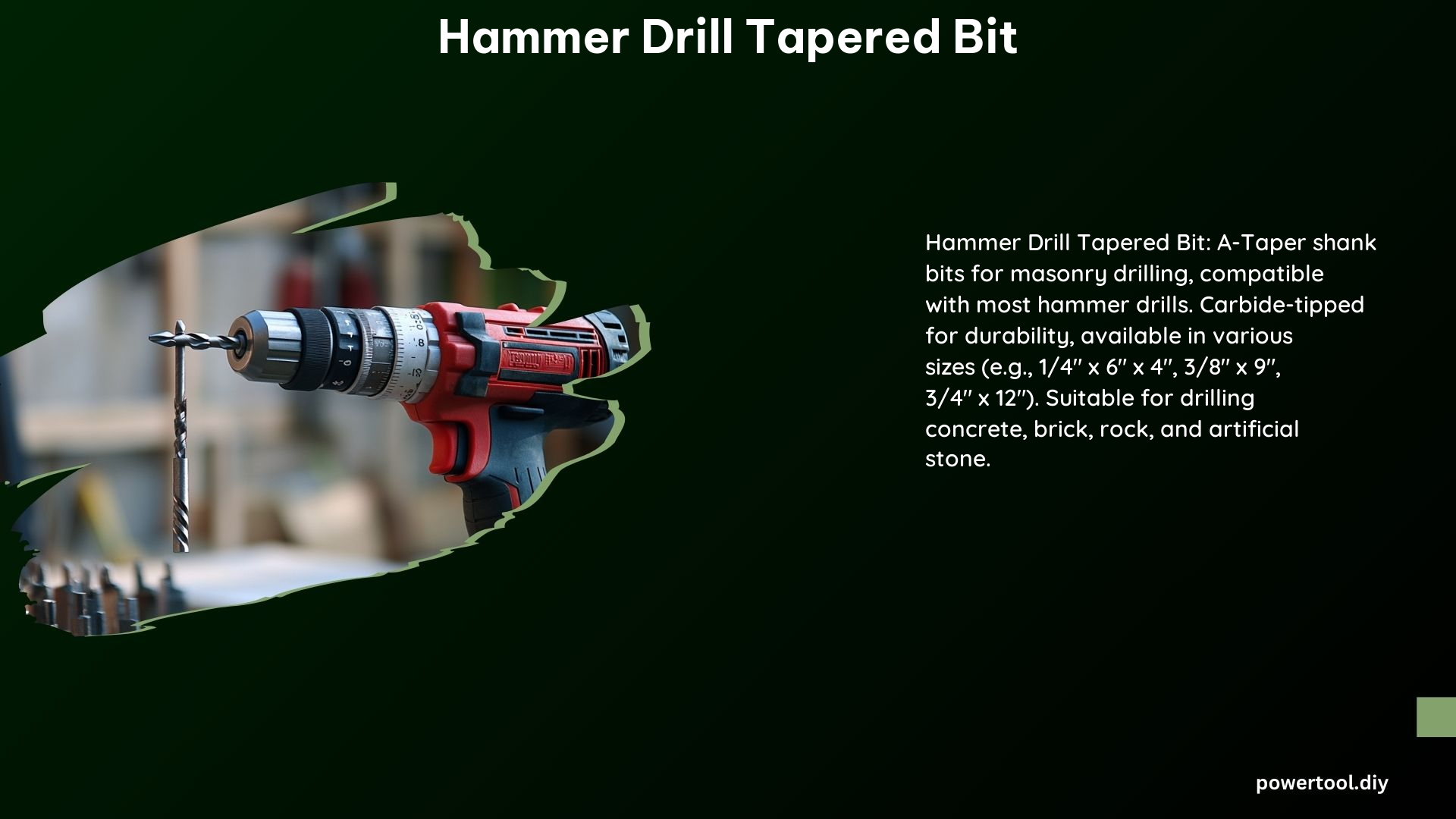A hammer drill tapered bit is a specialized tool designed for efficiently drilling into masonry materials such as concrete, brick, and rock. These bits are essential for a wide range of construction and renovation projects, from installing anchors and fasteners to creating openings for electrical and plumbing work.
Understanding the Hammer Drill Tapered Bit
Primary Purpose
The primary purpose of a hammer drill tapered bit is to combine rotary and hammering actions to effectively break down masonry materials into small granules. This simultaneous action allows for faster drilling and reduces the amount of pressure required on the bit, making the process more efficient and less strenuous on the user.
Masonry Materials
Hammer drill tapered bits are specifically designed for drilling into the following types of masonry materials:
- Concrete: From concrete structures and foundations to concrete blocks and pavers, these bits excel at creating holes in various concrete applications.
- Brick: Whether it’s a brick wall, chimney, or other masonry structure, hammer drill tapered bits can easily penetrate through brick.
- Rock: For drilling into hard rock formations, such as natural stone or artificial stone, these bits are the go-to choice.
- Artificial Stone: Masonry materials like concrete, stucco, and other synthetic stone products can also be effectively drilled using hammer drill tapered bits.
Bit Materials and Construction
To withstand the rigors of drilling into hard masonry materials, hammer drill tapered bits are typically made from high-quality, durable materials. The most common construction features include:
- Carbide-Tipped Steel: The cutting edges of the bit are tipped with tungsten carbide, a material known for its exceptional hardness and wear resistance.
- Reinforced Shank: The shank, or the part of the bit that fits into the hammer drill, is often reinforced to provide additional strength and stability during use.
- Fluted Design: The flutes, or spiral grooves, on the bit’s surface help to efficiently remove debris and dust from the drilling area, improving performance and extending the bit’s lifespan.
Technical Specifications

Hammer drill tapered bits come in a variety of sizes and configurations to accommodate different drilling needs. Here are some of the key technical specifications to consider:
| Specification | Range |
|---|---|
| Shank Type | Tapered round shank, compatible with rotary hammers |
| Drill Bit Size | 1/4″, 5/16″, 3/8″, 1/2″, and other common sizes |
| Overall Length | 6″ to 12″ |
| Maximum Drilling Depth | Up to 10″ |
| Bit Material | Carbide-tipped steel |
| Compliance | Meets ANSI B212.15 standard for masonry drill bits |
Ensuring Longevity and Performance
To maximize the lifespan and performance of your hammer drill tapered bit, it’s essential to follow these best practices:
-
Proper Bit Selection: Choose the correct bit size and type for the specific masonry material and drill you’re using. Mismatched bits can lead to premature wear and poor drilling results.
-
Regular Maintenance: Clean the bit thoroughly after each use to remove any debris or dust buildup. Inspect the cutting edges for signs of wear or damage, and replace the bit if necessary.
-
Appropriate Storage: Store the bit in a dry, protected environment to prevent corrosion or damage from environmental factors, such as moisture or extreme temperatures.
-
Careful Handling: Avoid dropping or impacting the bit, as this can cause damage to the cutting edges and the reinforced shank. Handle the bit with care during use and when transitioning between drilling tasks.
-
Optimal Drilling Technique: Follow the manufacturer’s recommended drilling speed, pressure, and technique to ensure efficient and effective drilling without overloading the bit.
By adhering to these guidelines, you can extend the lifespan of your hammer drill tapered bit and maintain its peak performance for a wide range of masonry drilling projects.
Conclusion
The hammer drill tapered bit is a versatile and essential tool for anyone working with masonry materials. Its ability to combine rotary and hammering actions makes it a highly effective solution for drilling into concrete, brick, rock, and other hard surfaces. By understanding the bit’s purpose, materials, and technical specifications, as well as following best practices for longevity and performance, you can ensure successful and efficient masonry drilling projects.
References
- Toolsid. (n.d.). Masonry & Hammer Drill Bits | Concrete, Coring, Smoothing, Impact. Retrieved from https://www.toolsid.com/masonry-hammer-drill-bits.html
- McMaster-Carr. (n.d.). A-Taper Masonry Drill Bits. Retrieved from https://www.mcmaster.com/products/a-taper-masonry-drill-bits/
- PAC FAS. (n.d.). ATB3166 – 3/16″ X 6″ A-Taper Masonry Drill Bit. Retrieved from https://www.pacfas.com/details/item?itemid=ATB3166&rt=%2FCategory%2Fpsearch%2F658%3Fwebdesc%3DA-TAPER%2520DRILL%2520BITS
- Oldham Chemical. (n.d.). Rockhard JHA-4 A-Taper Hammer Drill Bit – 1/4 in x 6 in. x 4 in. Retrieved from https://www.oldhamchem.com/rockhard-jha-4-a-taper-hammer-drill-bit-14-in-x-6-in-x-4-in
